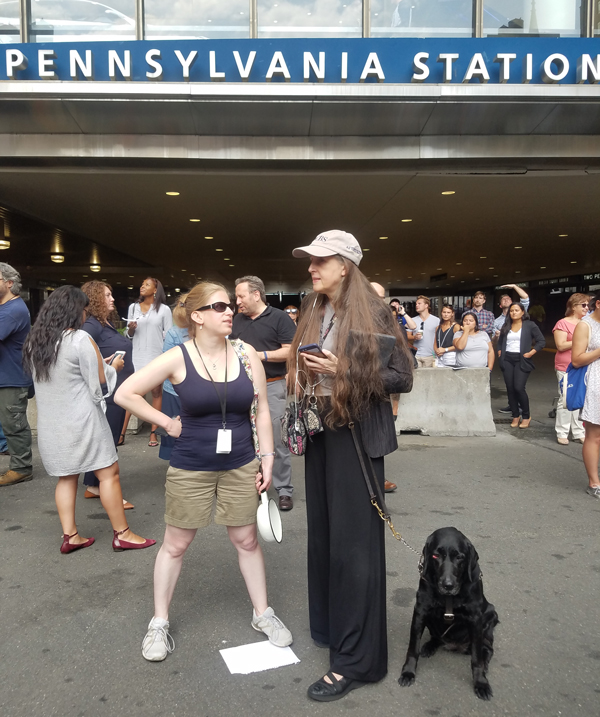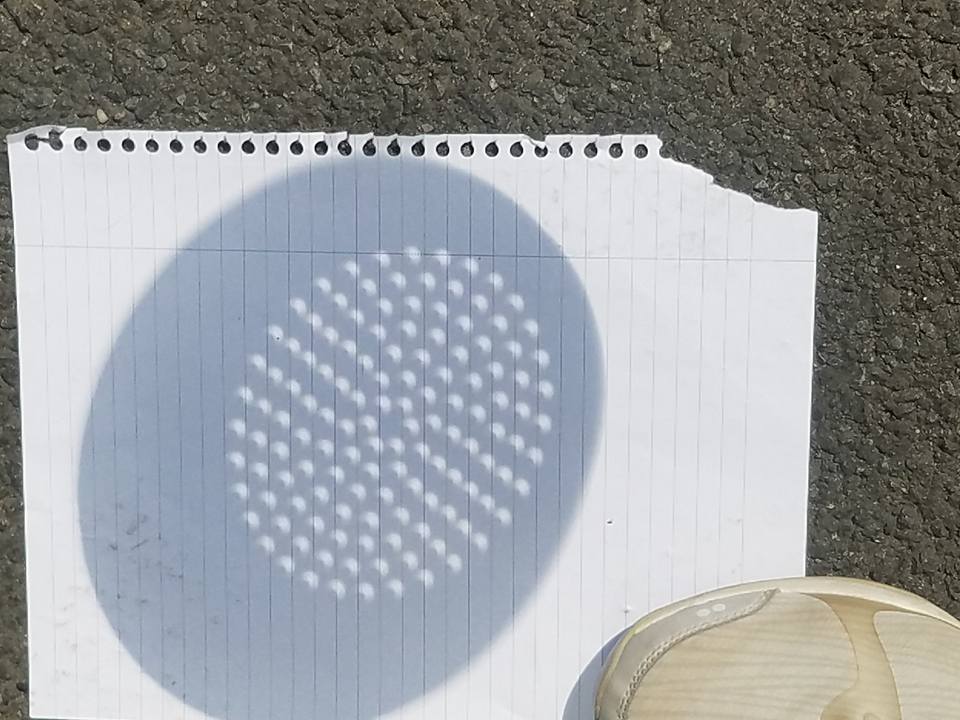Yesterday, AFB staff experienced the solar eclipse with a variety of high- and low-tech approaches.
Associate Director of Web Services Crista Earl used the new Eclipse Soundscapes App created by the Smithsonian Astrophysical Observatory and NASA’s Heliophysics Education Consortium. AFB Press Executive Editor Alina Vayntrub went old-school, using a colander to cast shadows of the eclipse against a white piece of paper. And Neva Fairchild, National Independent Living & Employment Specialist, listened to a livestream description from the American Council of the Blind.
Crista, how was your experience of the eclipse with the app?
Crista: The app was fun! It has three parts—one is you get a series of pictures of the different phases, and you can run your finger over them. It creates a tone that conveys the differences. It was interesting, but the pre-recorded human descriptions were even better. They were created in advance by WGBH, to give information about the major stages of the eclipse such as "Bailey's beads." It included the technical names of each phase, and gave you interesting scientific details about what caused the various effects. And the third part of the app were the push notifications, so you could get alerts specific to your area if you allowed location services.
Apparently the National Park Service was recording the sounds of wildlife, so I'm going to check today to see if those have been added to the app.
I have to say that the spontaneous descriptions from friends were really the best part of the eclipse. "It looks like a croissant! It's even golden!" They conveyed that the moon was crossing in from the left, and covering the bottom three-quarters of the sun.
Another wonderful discovery was that it was reflected in the windows of Madison Square Garden. A whole bunch of strangers gathered together, amazed. The crowd effect was the most fun.
Alina, can you tell us more about the colander viewing technique?
Alina: I wasn’t sure if I would be able to get eclipse glasses in time, so I decided to look up other ways to safely view the eclipse if I didn’t have the proper protective glasses. Some articles suggested using a colander with relatively large holes that could reflect the eclipse onto a white piece of paper. Luckily, I happened to have one handy at home and brought it in to test it out. It worked! Using the colander, instead of seeing one eclipse, we saw multiple eclipses through each of the individual holes.
Around the time of the totality of the eclipse, about 2:44 pm in NYC, two of our fellow building mates were returning to their offices and offered us their eclipse glasses. It was interesting to experience the eclipse in so many different ways: we listened using Crista’s Eclipse Soundscapes App, we saw the multiple little eclipses through the colander, we viewed it through the safety of the special eclipse glasses, and we also observed it in the reflection of the building windows. It was also exciting to see so many people in NYC who would typically pass one another on the street or in a building coming together to experience this rare event and share resources with one another. Can’t wait until 2024!
Neva, you took advantage of the audio description provided by ACB Radio. Can you tell us how that went?
That's right, I listened to the audio description of the total eclipse broadcast by ACB Radio by dialing in on my desk phone. My iPhone wasn’t working yesterday, of all days, so I relied on old school technology. The broadcast began with Dr. Joel talking about eclipse science and then an experienced describer told us what she could see from the courtyard of the Tennessee School for the Blind. She described how the sun looked like a very bright crescent moon with the shadow coming in from the left and moving oh so slowly that it was excruciatingly hard to wait for the totality. She talked about the color of the sky changing and compared the amount of light to a cloudy day, dusk, and then full night. She described the chirring of the crickets and cicadas, who typically only make sound as night approaches.
Unfortunately, the sun was covered by a storm cloud during most of the totality of the eclipse, but she said that sometimes when the cloud shifted the sun rays would be visible in the corona and that the cloud sometimes appeared to be glowing. I felt as if I were there, and the excitement of the crowd was also described. People were silent as the eclipse moved toward totality. When darkness was most prominent, the crowd became noisier and the excitement was palpable. As the sun made its reappearance, the novelty was over and people went back to their classes or offices long before the full sun was visible. Short of being there in person, having the total eclipse described was ideal for me.
How was your own experience of the eclipse? Let us know in the comments!


